The Content of Fly Ash and Its Diverse Applications
VerifiedAdded on 2020/05/01
|10
|3860
|105
Report
AI Summary
This report examines the content and applications of fly ash, a byproduct of coal combustion, in concrete production. It begins with an executive summary and introduction, highlighting fly ash's role as a supplementary cementitious material (SCM) and its economic and environmental benefits. A literature review explores various aspects, including fly ash's impact on fresh and hardened concrete, its advantages (such as cold weather resistance and reduced water requirements), and its diverse uses in infrastructure projects like roads and bridges. The research questions, aims, and objectives are defined, focusing on the effects of fly ash on concrete properties and durability. The methodology involves mix concrete with fine mineral dust, comparing it with ordinary concrete and testing for strength, durability, and workability using slump and compaction tests. Various methods for incorporating fly ash, such as simple replacement and addition methods, are discussed. The experimental setup involves multistage mixing with different cement replacement levels. The report highlights the positive environmental impact of fly ash, such as reducing landfill space and greenhouse gas emissions. The report concludes that fly ash can improve concrete's workability, durability, and overall performance, making it a valuable material in construction.
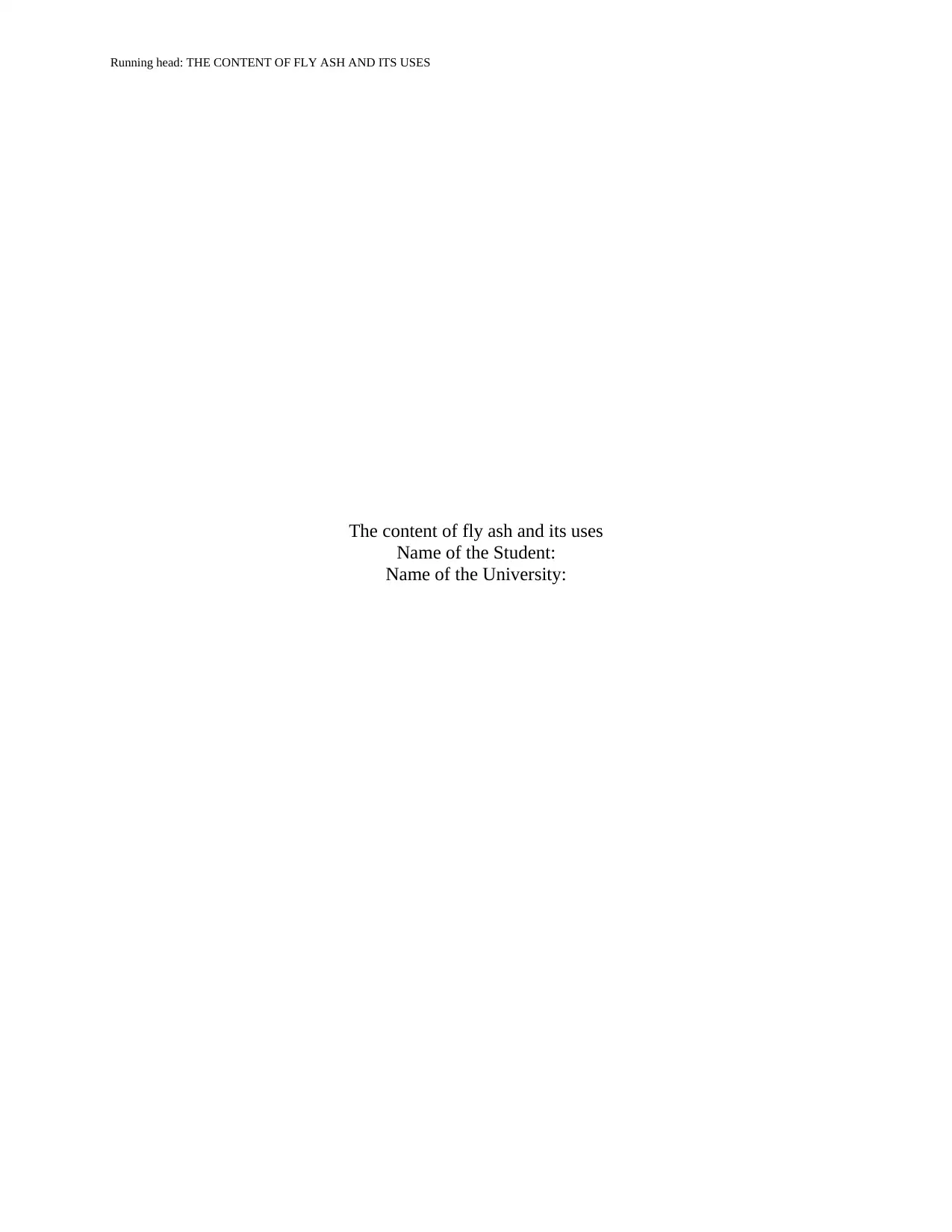
Running head: THE CONTENT OF FLY ASH AND ITS USES
The content of fly ash and its uses
Name of the Student:
Name of the University:
The content of fly ash and its uses
Name of the Student:
Name of the University:
Paraphrase This Document
Need a fresh take? Get an instant paraphrase of this document with our AI Paraphraser
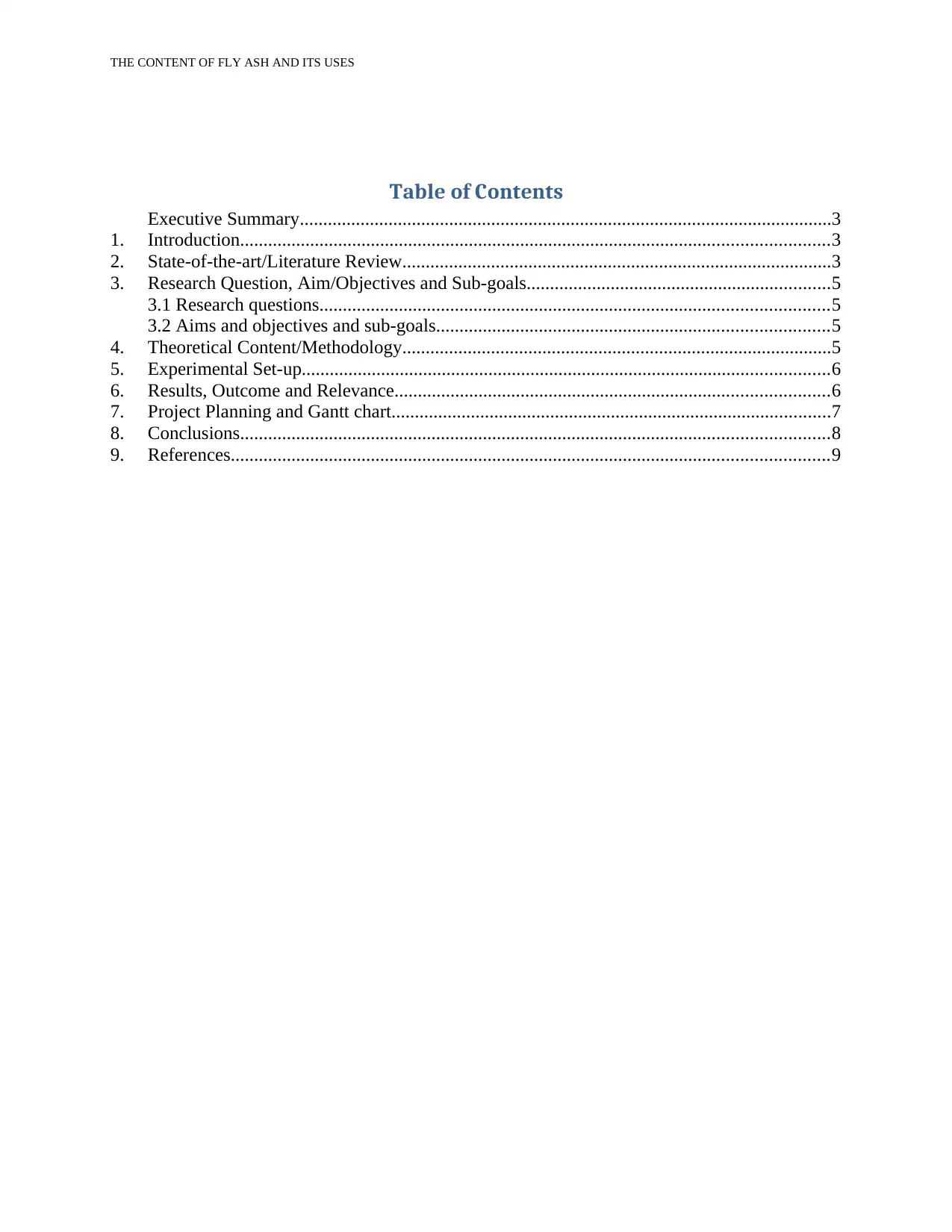
THE CONTENT OF FLY ASH AND ITS USES
Table of Contents
Executive Summary..................................................................................................................3
1. Introduction..............................................................................................................................3
2. State-of-the-art/Literature Review............................................................................................3
3. Research Question, Aim/Objectives and Sub-goals.................................................................5
3.1 Research questions.............................................................................................................5
3.2 Aims and objectives and sub-goals....................................................................................5
4. Theoretical Content/Methodology............................................................................................5
5. Experimental Set-up.................................................................................................................6
6. Results, Outcome and Relevance.............................................................................................6
7. Project Planning and Gantt chart..............................................................................................7
8. Conclusions..............................................................................................................................8
9. References................................................................................................................................9
Table of Contents
Executive Summary..................................................................................................................3
1. Introduction..............................................................................................................................3
2. State-of-the-art/Literature Review............................................................................................3
3. Research Question, Aim/Objectives and Sub-goals.................................................................5
3.1 Research questions.............................................................................................................5
3.2 Aims and objectives and sub-goals....................................................................................5
4. Theoretical Content/Methodology............................................................................................5
5. Experimental Set-up.................................................................................................................6
6. Results, Outcome and Relevance.............................................................................................6
7. Project Planning and Gantt chart..............................................................................................7
8. Conclusions..............................................................................................................................8
9. References................................................................................................................................9
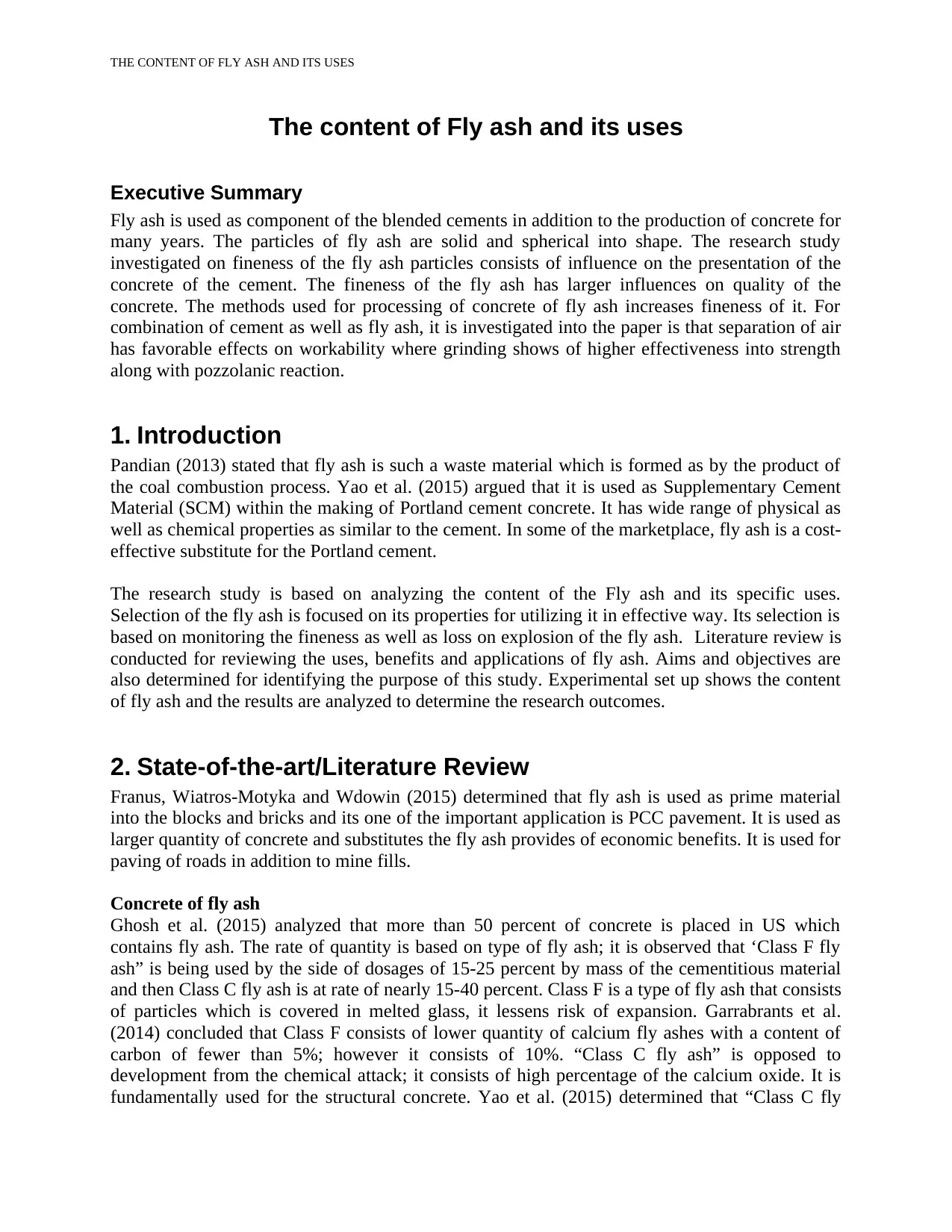
THE CONTENT OF FLY ASH AND ITS USES
The content of Fly ash and its uses
Executive Summary
Fly ash is used as component of the blended cements in addition to the production of concrete for
many years. The particles of fly ash are solid and spherical into shape. The research study
investigated on fineness of the fly ash particles consists of influence on the presentation of the
concrete of the cement. The fineness of the fly ash has larger influences on quality of the
concrete. The methods used for processing of concrete of fly ash increases fineness of it. For
combination of cement as well as fly ash, it is investigated into the paper is that separation of air
has favorable effects on workability where grinding shows of higher effectiveness into strength
along with pozzolanic reaction.
1. Introduction
Pandian (2013) stated that fly ash is such a waste material which is formed as by the product of
the coal combustion process. Yao et al. (2015) argued that it is used as Supplementary Cement
Material (SCM) within the making of Portland cement concrete. It has wide range of physical as
well as chemical properties as similar to the cement. In some of the marketplace, fly ash is a cost-
effective substitute for the Portland cement.
The research study is based on analyzing the content of the Fly ash and its specific uses.
Selection of the fly ash is focused on its properties for utilizing it in effective way. Its selection is
based on monitoring the fineness as well as loss on explosion of the fly ash. Literature review is
conducted for reviewing the uses, benefits and applications of fly ash. Aims and objectives are
also determined for identifying the purpose of this study. Experimental set up shows the content
of fly ash and the results are analyzed to determine the research outcomes.
2. State-of-the-art/Literature Review
Franus, Wiatros-Motyka and Wdowin (2015) determined that fly ash is used as prime material
into the blocks and bricks and its one of the important application is PCC pavement. It is used as
larger quantity of concrete and substitutes the fly ash provides of economic benefits. It is used for
paving of roads in addition to mine fills.
Concrete of fly ash
Ghosh et al. (2015) analyzed that more than 50 percent of concrete is placed in US which
contains fly ash. The rate of quantity is based on type of fly ash; it is observed that ‘Class F fly
ash” is being used by the side of dosages of 15-25 percent by mass of the cementitious material
and then Class C fly ash is at rate of nearly 15-40 percent. Class F is a type of fly ash that consists
of particles which is covered in melted glass, it lessens risk of expansion. Garrabrants et al.
(2014) concluded that Class F consists of lower quantity of calcium fly ashes with a content of
carbon of fewer than 5%; however it consists of 10%. “Class C fly ash” is opposed to
development from the chemical attack; it consists of high percentage of the calcium oxide. It is
fundamentally used for the structural concrete. Yao et al. (2015) determined that “Class C fly
The content of Fly ash and its uses
Executive Summary
Fly ash is used as component of the blended cements in addition to the production of concrete for
many years. The particles of fly ash are solid and spherical into shape. The research study
investigated on fineness of the fly ash particles consists of influence on the presentation of the
concrete of the cement. The fineness of the fly ash has larger influences on quality of the
concrete. The methods used for processing of concrete of fly ash increases fineness of it. For
combination of cement as well as fly ash, it is investigated into the paper is that separation of air
has favorable effects on workability where grinding shows of higher effectiveness into strength
along with pozzolanic reaction.
1. Introduction
Pandian (2013) stated that fly ash is such a waste material which is formed as by the product of
the coal combustion process. Yao et al. (2015) argued that it is used as Supplementary Cement
Material (SCM) within the making of Portland cement concrete. It has wide range of physical as
well as chemical properties as similar to the cement. In some of the marketplace, fly ash is a cost-
effective substitute for the Portland cement.
The research study is based on analyzing the content of the Fly ash and its specific uses.
Selection of the fly ash is focused on its properties for utilizing it in effective way. Its selection is
based on monitoring the fineness as well as loss on explosion of the fly ash. Literature review is
conducted for reviewing the uses, benefits and applications of fly ash. Aims and objectives are
also determined for identifying the purpose of this study. Experimental set up shows the content
of fly ash and the results are analyzed to determine the research outcomes.
2. State-of-the-art/Literature Review
Franus, Wiatros-Motyka and Wdowin (2015) determined that fly ash is used as prime material
into the blocks and bricks and its one of the important application is PCC pavement. It is used as
larger quantity of concrete and substitutes the fly ash provides of economic benefits. It is used for
paving of roads in addition to mine fills.
Concrete of fly ash
Ghosh et al. (2015) analyzed that more than 50 percent of concrete is placed in US which
contains fly ash. The rate of quantity is based on type of fly ash; it is observed that ‘Class F fly
ash” is being used by the side of dosages of 15-25 percent by mass of the cementitious material
and then Class C fly ash is at rate of nearly 15-40 percent. Class F is a type of fly ash that consists
of particles which is covered in melted glass, it lessens risk of expansion. Garrabrants et al.
(2014) concluded that Class F consists of lower quantity of calcium fly ashes with a content of
carbon of fewer than 5%; however it consists of 10%. “Class C fly ash” is opposed to
development from the chemical attack; it consists of high percentage of the calcium oxide. It is
fundamentally used for the structural concrete. Yao et al. (2015) determined that “Class C fly
⊘ This is a preview!⊘
Do you want full access?
Subscribe today to unlock all pages.

Trusted by 1+ million students worldwide
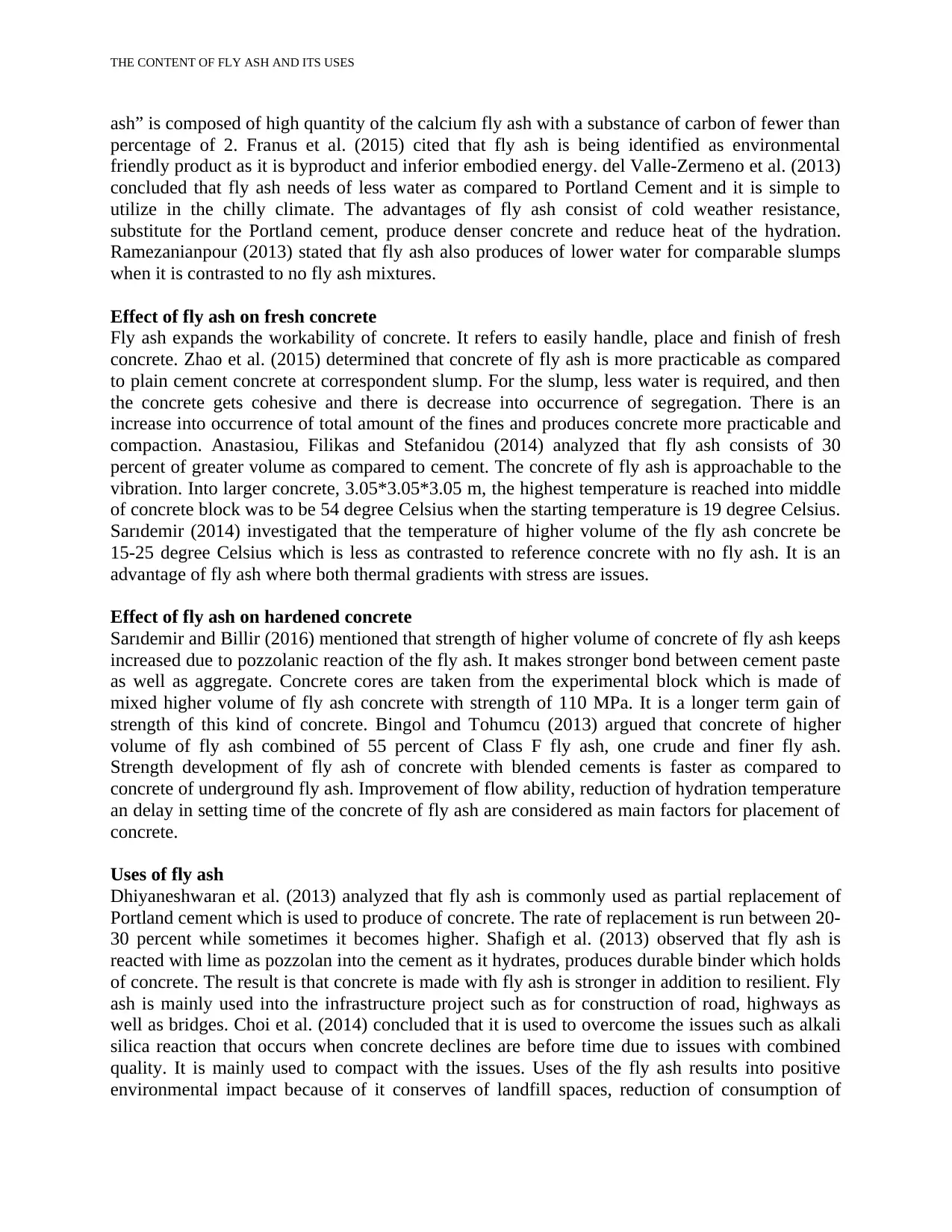
THE CONTENT OF FLY ASH AND ITS USES
ash” is composed of high quantity of the calcium fly ash with a substance of carbon of fewer than
percentage of 2. Franus et al. (2015) cited that fly ash is being identified as environmental
friendly product as it is byproduct and inferior embodied energy. del Valle-Zermeno et al. (2013)
concluded that fly ash needs of less water as compared to Portland Cement and it is simple to
utilize in the chilly climate. The advantages of fly ash consist of cold weather resistance,
substitute for the Portland cement, produce denser concrete and reduce heat of the hydration.
Ramezanianpour (2013) stated that fly ash also produces of lower water for comparable slumps
when it is contrasted to no fly ash mixtures.
Effect of fly ash on fresh concrete
Fly ash expands the workability of concrete. It refers to easily handle, place and finish of fresh
concrete. Zhao et al. (2015) determined that concrete of fly ash is more practicable as compared
to plain cement concrete at correspondent slump. For the slump, less water is required, and then
the concrete gets cohesive and there is decrease into occurrence of segregation. There is an
increase into occurrence of total amount of the fines and produces concrete more practicable and
compaction. Anastasiou, Filikas and Stefanidou (2014) analyzed that fly ash consists of 30
percent of greater volume as compared to cement. The concrete of fly ash is approachable to the
vibration. Into larger concrete, 3.05*3.05*3.05 m, the highest temperature is reached into middle
of concrete block was to be 54 degree Celsius when the starting temperature is 19 degree Celsius.
Sarıdemir (2014) investigated that the temperature of higher volume of the fly ash concrete be
15-25 degree Celsius which is less as contrasted to reference concrete with no fly ash. It is an
advantage of fly ash where both thermal gradients with stress are issues.
Effect of fly ash on hardened concrete
Sarıdemir and Billir (2016) mentioned that strength of higher volume of concrete of fly ash keeps
increased due to pozzolanic reaction of the fly ash. It makes stronger bond between cement paste
as well as aggregate. Concrete cores are taken from the experimental block which is made of
mixed higher volume of fly ash concrete with strength of 110 MPa. It is a longer term gain of
strength of this kind of concrete. Bingol and Tohumcu (2013) argued that concrete of higher
volume of fly ash combined of 55 percent of Class F fly ash, one crude and finer fly ash.
Strength development of fly ash of concrete with blended cements is faster as compared to
concrete of underground fly ash. Improvement of flow ability, reduction of hydration temperature
an delay in setting time of the concrete of fly ash are considered as main factors for placement of
concrete.
Uses of fly ash
Dhiyaneshwaran et al. (2013) analyzed that fly ash is commonly used as partial replacement of
Portland cement which is used to produce of concrete. The rate of replacement is run between 20-
30 percent while sometimes it becomes higher. Shafigh et al. (2013) observed that fly ash is
reacted with lime as pozzolan into the cement as it hydrates, produces durable binder which holds
of concrete. The result is that concrete is made with fly ash is stronger in addition to resilient. Fly
ash is mainly used into the infrastructure project such as for construction of road, highways as
well as bridges. Choi et al. (2014) concluded that it is used to overcome the issues such as alkali
silica reaction that occurs when concrete declines are before time due to issues with combined
quality. It is mainly used to compact with the issues. Uses of the fly ash results into positive
environmental impact because of it conserves of landfill spaces, reduction of consumption of
ash” is composed of high quantity of the calcium fly ash with a substance of carbon of fewer than
percentage of 2. Franus et al. (2015) cited that fly ash is being identified as environmental
friendly product as it is byproduct and inferior embodied energy. del Valle-Zermeno et al. (2013)
concluded that fly ash needs of less water as compared to Portland Cement and it is simple to
utilize in the chilly climate. The advantages of fly ash consist of cold weather resistance,
substitute for the Portland cement, produce denser concrete and reduce heat of the hydration.
Ramezanianpour (2013) stated that fly ash also produces of lower water for comparable slumps
when it is contrasted to no fly ash mixtures.
Effect of fly ash on fresh concrete
Fly ash expands the workability of concrete. It refers to easily handle, place and finish of fresh
concrete. Zhao et al. (2015) determined that concrete of fly ash is more practicable as compared
to plain cement concrete at correspondent slump. For the slump, less water is required, and then
the concrete gets cohesive and there is decrease into occurrence of segregation. There is an
increase into occurrence of total amount of the fines and produces concrete more practicable and
compaction. Anastasiou, Filikas and Stefanidou (2014) analyzed that fly ash consists of 30
percent of greater volume as compared to cement. The concrete of fly ash is approachable to the
vibration. Into larger concrete, 3.05*3.05*3.05 m, the highest temperature is reached into middle
of concrete block was to be 54 degree Celsius when the starting temperature is 19 degree Celsius.
Sarıdemir (2014) investigated that the temperature of higher volume of the fly ash concrete be
15-25 degree Celsius which is less as contrasted to reference concrete with no fly ash. It is an
advantage of fly ash where both thermal gradients with stress are issues.
Effect of fly ash on hardened concrete
Sarıdemir and Billir (2016) mentioned that strength of higher volume of concrete of fly ash keeps
increased due to pozzolanic reaction of the fly ash. It makes stronger bond between cement paste
as well as aggregate. Concrete cores are taken from the experimental block which is made of
mixed higher volume of fly ash concrete with strength of 110 MPa. It is a longer term gain of
strength of this kind of concrete. Bingol and Tohumcu (2013) argued that concrete of higher
volume of fly ash combined of 55 percent of Class F fly ash, one crude and finer fly ash.
Strength development of fly ash of concrete with blended cements is faster as compared to
concrete of underground fly ash. Improvement of flow ability, reduction of hydration temperature
an delay in setting time of the concrete of fly ash are considered as main factors for placement of
concrete.
Uses of fly ash
Dhiyaneshwaran et al. (2013) analyzed that fly ash is commonly used as partial replacement of
Portland cement which is used to produce of concrete. The rate of replacement is run between 20-
30 percent while sometimes it becomes higher. Shafigh et al. (2013) observed that fly ash is
reacted with lime as pozzolan into the cement as it hydrates, produces durable binder which holds
of concrete. The result is that concrete is made with fly ash is stronger in addition to resilient. Fly
ash is mainly used into the infrastructure project such as for construction of road, highways as
well as bridges. Choi et al. (2014) concluded that it is used to overcome the issues such as alkali
silica reaction that occurs when concrete declines are before time due to issues with combined
quality. It is mainly used to compact with the issues. Uses of the fly ash results into positive
environmental impact because of it conserves of landfill spaces, reduction of consumption of
Paraphrase This Document
Need a fresh take? Get an instant paraphrase of this document with our AI Paraphraser
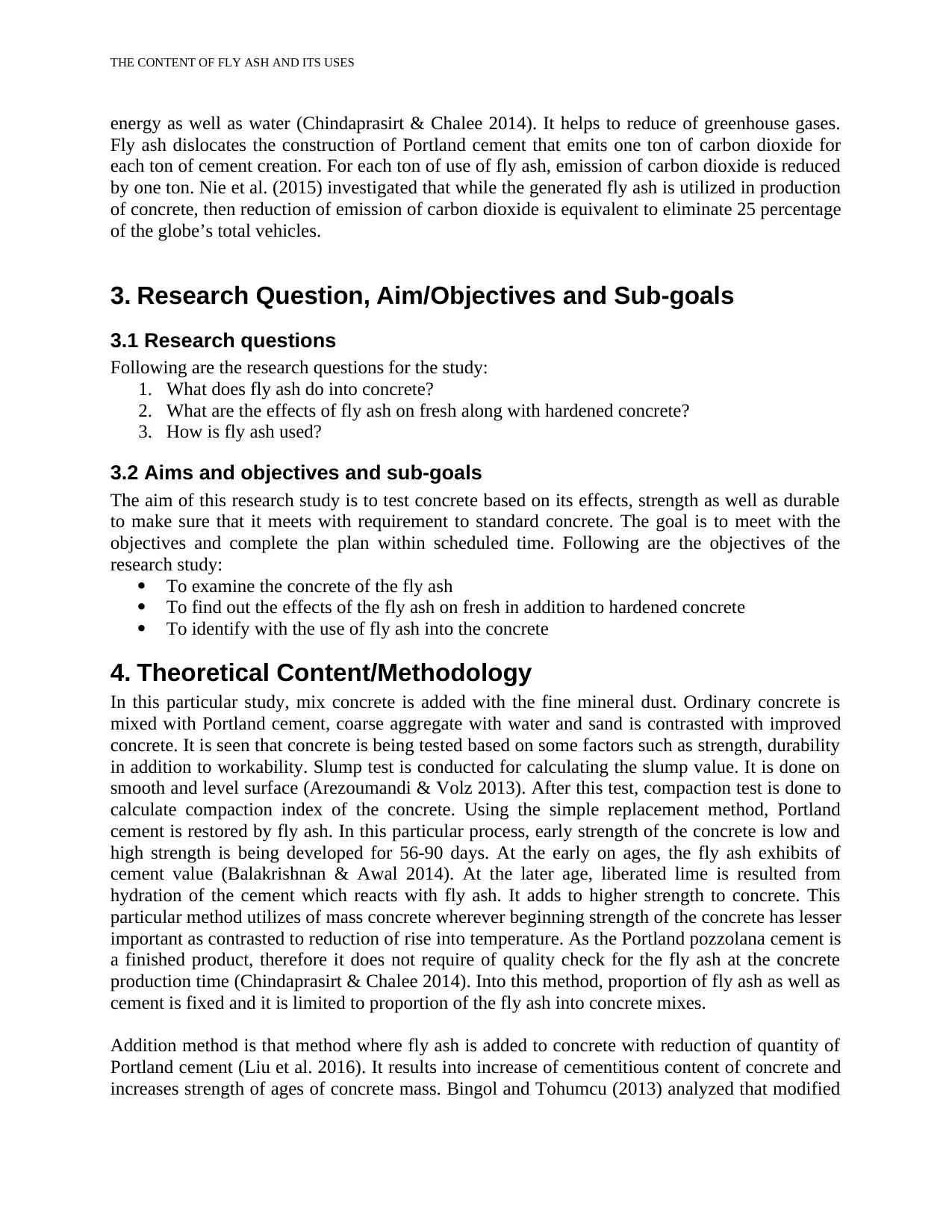
THE CONTENT OF FLY ASH AND ITS USES
energy as well as water (Chindaprasirt & Chalee 2014). It helps to reduce of greenhouse gases.
Fly ash dislocates the construction of Portland cement that emits one ton of carbon dioxide for
each ton of cement creation. For each ton of use of fly ash, emission of carbon dioxide is reduced
by one ton. Nie et al. (2015) investigated that while the generated fly ash is utilized in production
of concrete, then reduction of emission of carbon dioxide is equivalent to eliminate 25 percentage
of the globe’s total vehicles.
3. Research Question, Aim/Objectives and Sub-goals
3.1 Research questions
Following are the research questions for the study:
1. What does fly ash do into concrete?
2. What are the effects of fly ash on fresh along with hardened concrete?
3. How is fly ash used?
3.2 Aims and objectives and sub-goals
The aim of this research study is to test concrete based on its effects, strength as well as durable
to make sure that it meets with requirement to standard concrete. The goal is to meet with the
objectives and complete the plan within scheduled time. Following are the objectives of the
research study:
To examine the concrete of the fly ash
To find out the effects of the fly ash on fresh in addition to hardened concrete
To identify with the use of fly ash into the concrete
4. Theoretical Content/Methodology
In this particular study, mix concrete is added with the fine mineral dust. Ordinary concrete is
mixed with Portland cement, coarse aggregate with water and sand is contrasted with improved
concrete. It is seen that concrete is being tested based on some factors such as strength, durability
in addition to workability. Slump test is conducted for calculating the slump value. It is done on
smooth and level surface (Arezoumandi & Volz 2013). After this test, compaction test is done to
calculate compaction index of the concrete. Using the simple replacement method, Portland
cement is restored by fly ash. In this particular process, early strength of the concrete is low and
high strength is being developed for 56-90 days. At the early on ages, the fly ash exhibits of
cement value (Balakrishnan & Awal 2014). At the later age, liberated lime is resulted from
hydration of the cement which reacts with fly ash. It adds to higher strength to concrete. This
particular method utilizes of mass concrete wherever beginning strength of the concrete has lesser
important as contrasted to reduction of rise into temperature. As the Portland pozzolana cement is
a finished product, therefore it does not require of quality check for the fly ash at the concrete
production time (Chindaprasirt & Chalee 2014). Into this method, proportion of fly ash as well as
cement is fixed and it is limited to proportion of the fly ash into concrete mixes.
Addition method is that method where fly ash is added to concrete with reduction of quantity of
Portland cement (Liu et al. 2016). It results into increase of cementitious content of concrete and
increases strength of ages of concrete mass. Bingol and Tohumcu (2013) analyzed that modified
energy as well as water (Chindaprasirt & Chalee 2014). It helps to reduce of greenhouse gases.
Fly ash dislocates the construction of Portland cement that emits one ton of carbon dioxide for
each ton of cement creation. For each ton of use of fly ash, emission of carbon dioxide is reduced
by one ton. Nie et al. (2015) investigated that while the generated fly ash is utilized in production
of concrete, then reduction of emission of carbon dioxide is equivalent to eliminate 25 percentage
of the globe’s total vehicles.
3. Research Question, Aim/Objectives and Sub-goals
3.1 Research questions
Following are the research questions for the study:
1. What does fly ash do into concrete?
2. What are the effects of fly ash on fresh along with hardened concrete?
3. How is fly ash used?
3.2 Aims and objectives and sub-goals
The aim of this research study is to test concrete based on its effects, strength as well as durable
to make sure that it meets with requirement to standard concrete. The goal is to meet with the
objectives and complete the plan within scheduled time. Following are the objectives of the
research study:
To examine the concrete of the fly ash
To find out the effects of the fly ash on fresh in addition to hardened concrete
To identify with the use of fly ash into the concrete
4. Theoretical Content/Methodology
In this particular study, mix concrete is added with the fine mineral dust. Ordinary concrete is
mixed with Portland cement, coarse aggregate with water and sand is contrasted with improved
concrete. It is seen that concrete is being tested based on some factors such as strength, durability
in addition to workability. Slump test is conducted for calculating the slump value. It is done on
smooth and level surface (Arezoumandi & Volz 2013). After this test, compaction test is done to
calculate compaction index of the concrete. Using the simple replacement method, Portland
cement is restored by fly ash. In this particular process, early strength of the concrete is low and
high strength is being developed for 56-90 days. At the early on ages, the fly ash exhibits of
cement value (Balakrishnan & Awal 2014). At the later age, liberated lime is resulted from
hydration of the cement which reacts with fly ash. It adds to higher strength to concrete. This
particular method utilizes of mass concrete wherever beginning strength of the concrete has lesser
important as contrasted to reduction of rise into temperature. As the Portland pozzolana cement is
a finished product, therefore it does not require of quality check for the fly ash at the concrete
production time (Chindaprasirt & Chalee 2014). Into this method, proportion of fly ash as well as
cement is fixed and it is limited to proportion of the fly ash into concrete mixes.
Addition method is that method where fly ash is added to concrete with reduction of quantity of
Portland cement (Liu et al. 2016). It results into increase of cementitious content of concrete and
increases strength of ages of concrete mass. Bingol and Tohumcu (2013) analyzed that modified
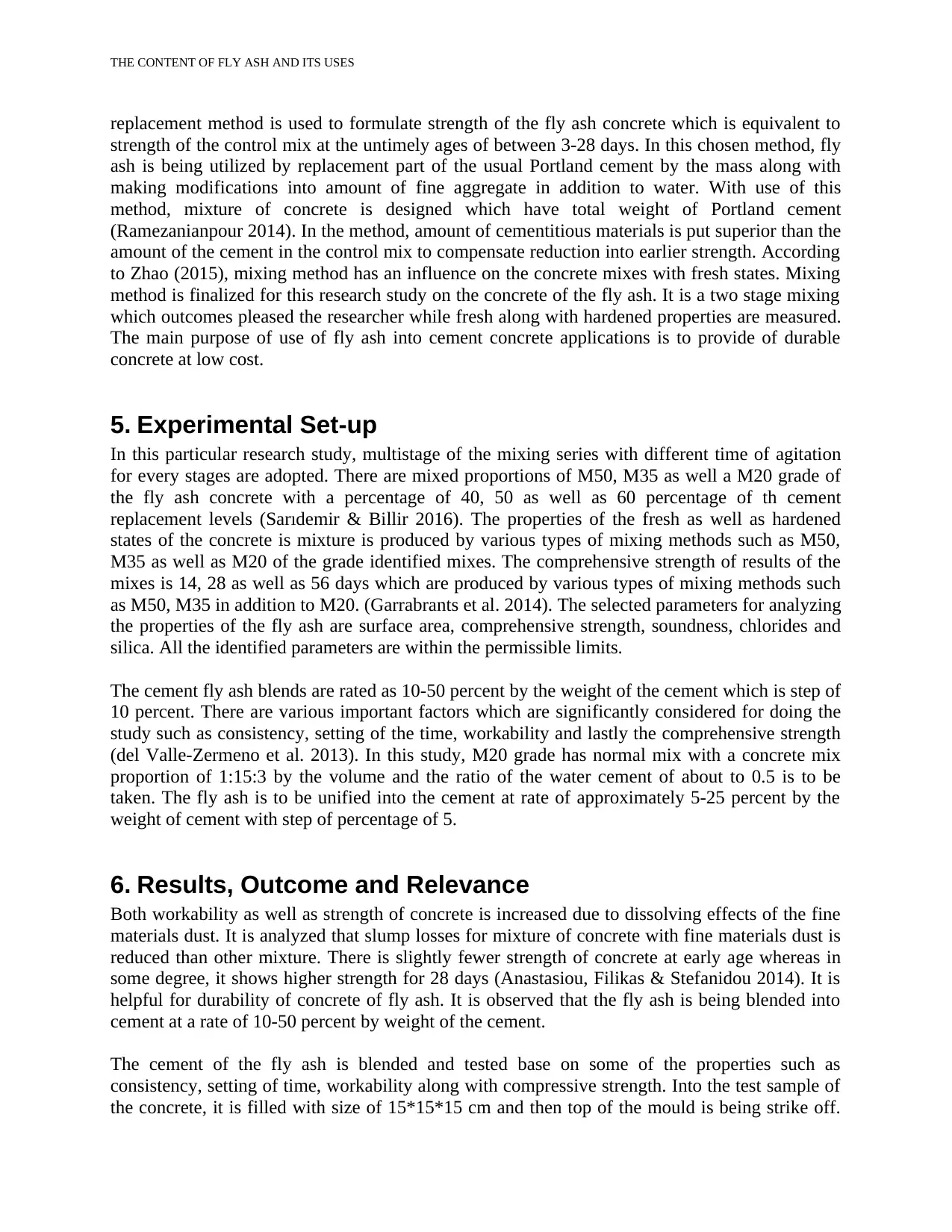
THE CONTENT OF FLY ASH AND ITS USES
replacement method is used to formulate strength of the fly ash concrete which is equivalent to
strength of the control mix at the untimely ages of between 3-28 days. In this chosen method, fly
ash is being utilized by replacement part of the usual Portland cement by the mass along with
making modifications into amount of fine aggregate in addition to water. With use of this
method, mixture of concrete is designed which have total weight of Portland cement
(Ramezanianpour 2014). In the method, amount of cementitious materials is put superior than the
amount of the cement in the control mix to compensate reduction into earlier strength. According
to Zhao (2015), mixing method has an influence on the concrete mixes with fresh states. Mixing
method is finalized for this research study on the concrete of the fly ash. It is a two stage mixing
which outcomes pleased the researcher while fresh along with hardened properties are measured.
The main purpose of use of fly ash into cement concrete applications is to provide of durable
concrete at low cost.
5. Experimental Set-up
In this particular research study, multistage of the mixing series with different time of agitation
for every stages are adopted. There are mixed proportions of M50, M35 as well a M20 grade of
the fly ash concrete with a percentage of 40, 50 as well as 60 percentage of th cement
replacement levels (Sarıdemir & Billir 2016). The properties of the fresh as well as hardened
states of the concrete is mixture is produced by various types of mixing methods such as M50,
M35 as well as M20 of the grade identified mixes. The comprehensive strength of results of the
mixes is 14, 28 as well as 56 days which are produced by various types of mixing methods such
as M50, M35 in addition to M20. (Garrabrants et al. 2014). The selected parameters for analyzing
the properties of the fly ash are surface area, comprehensive strength, soundness, chlorides and
silica. All the identified parameters are within the permissible limits.
The cement fly ash blends are rated as 10-50 percent by the weight of the cement which is step of
10 percent. There are various important factors which are significantly considered for doing the
study such as consistency, setting of the time, workability and lastly the comprehensive strength
(del Valle-Zermeno et al. 2013). In this study, M20 grade has normal mix with a concrete mix
proportion of 1:15:3 by the volume and the ratio of the water cement of about to 0.5 is to be
taken. The fly ash is to be unified into the cement at rate of approximately 5-25 percent by the
weight of cement with step of percentage of 5.
6. Results, Outcome and Relevance
Both workability as well as strength of concrete is increased due to dissolving effects of the fine
materials dust. It is analyzed that slump losses for mixture of concrete with fine materials dust is
reduced than other mixture. There is slightly fewer strength of concrete at early age whereas in
some degree, it shows higher strength for 28 days (Anastasiou, Filikas & Stefanidou 2014). It is
helpful for durability of concrete of fly ash. It is observed that the fly ash is being blended into
cement at a rate of 10-50 percent by weight of the cement.
The cement of the fly ash is blended and tested base on some of the properties such as
consistency, setting of time, workability along with compressive strength. Into the test sample of
the concrete, it is filled with size of 15*15*15 cm and then top of the mould is being strike off.
replacement method is used to formulate strength of the fly ash concrete which is equivalent to
strength of the control mix at the untimely ages of between 3-28 days. In this chosen method, fly
ash is being utilized by replacement part of the usual Portland cement by the mass along with
making modifications into amount of fine aggregate in addition to water. With use of this
method, mixture of concrete is designed which have total weight of Portland cement
(Ramezanianpour 2014). In the method, amount of cementitious materials is put superior than the
amount of the cement in the control mix to compensate reduction into earlier strength. According
to Zhao (2015), mixing method has an influence on the concrete mixes with fresh states. Mixing
method is finalized for this research study on the concrete of the fly ash. It is a two stage mixing
which outcomes pleased the researcher while fresh along with hardened properties are measured.
The main purpose of use of fly ash into cement concrete applications is to provide of durable
concrete at low cost.
5. Experimental Set-up
In this particular research study, multistage of the mixing series with different time of agitation
for every stages are adopted. There are mixed proportions of M50, M35 as well a M20 grade of
the fly ash concrete with a percentage of 40, 50 as well as 60 percentage of th cement
replacement levels (Sarıdemir & Billir 2016). The properties of the fresh as well as hardened
states of the concrete is mixture is produced by various types of mixing methods such as M50,
M35 as well as M20 of the grade identified mixes. The comprehensive strength of results of the
mixes is 14, 28 as well as 56 days which are produced by various types of mixing methods such
as M50, M35 in addition to M20. (Garrabrants et al. 2014). The selected parameters for analyzing
the properties of the fly ash are surface area, comprehensive strength, soundness, chlorides and
silica. All the identified parameters are within the permissible limits.
The cement fly ash blends are rated as 10-50 percent by the weight of the cement which is step of
10 percent. There are various important factors which are significantly considered for doing the
study such as consistency, setting of the time, workability and lastly the comprehensive strength
(del Valle-Zermeno et al. 2013). In this study, M20 grade has normal mix with a concrete mix
proportion of 1:15:3 by the volume and the ratio of the water cement of about to 0.5 is to be
taken. The fly ash is to be unified into the cement at rate of approximately 5-25 percent by the
weight of cement with step of percentage of 5.
6. Results, Outcome and Relevance
Both workability as well as strength of concrete is increased due to dissolving effects of the fine
materials dust. It is analyzed that slump losses for mixture of concrete with fine materials dust is
reduced than other mixture. There is slightly fewer strength of concrete at early age whereas in
some degree, it shows higher strength for 28 days (Anastasiou, Filikas & Stefanidou 2014). It is
helpful for durability of concrete of fly ash. It is observed that the fly ash is being blended into
cement at a rate of 10-50 percent by weight of the cement.
The cement of the fly ash is blended and tested base on some of the properties such as
consistency, setting of time, workability along with compressive strength. Into the test sample of
the concrete, it is filled with size of 15*15*15 cm and then top of the mould is being strike off.
⊘ This is a preview!⊘
Do you want full access?
Subscribe today to unlock all pages.

Trusted by 1+ million students worldwide
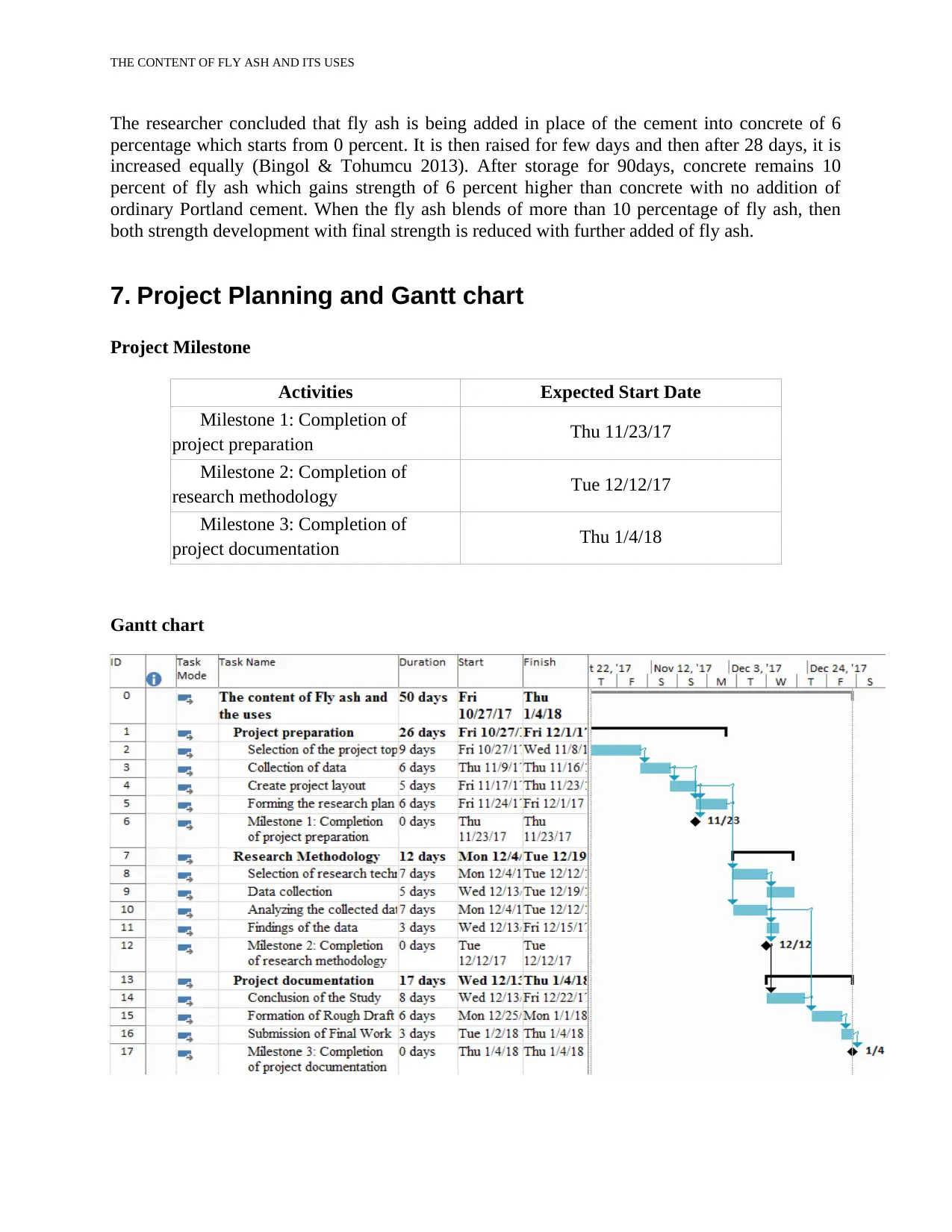
THE CONTENT OF FLY ASH AND ITS USES
The researcher concluded that fly ash is being added in place of the cement into concrete of 6
percentage which starts from 0 percent. It is then raised for few days and then after 28 days, it is
increased equally (Bingol & Tohumcu 2013). After storage for 90days, concrete remains 10
percent of fly ash which gains strength of 6 percent higher than concrete with no addition of
ordinary Portland cement. When the fly ash blends of more than 10 percentage of fly ash, then
both strength development with final strength is reduced with further added of fly ash.
7. Project Planning and Gantt chart
Project Milestone
Activities Expected Start Date
Milestone 1: Completion of
project preparation Thu 11/23/17
Milestone 2: Completion of
research methodology Tue 12/12/17
Milestone 3: Completion of
project documentation Thu 1/4/18
Gantt chart
The researcher concluded that fly ash is being added in place of the cement into concrete of 6
percentage which starts from 0 percent. It is then raised for few days and then after 28 days, it is
increased equally (Bingol & Tohumcu 2013). After storage for 90days, concrete remains 10
percent of fly ash which gains strength of 6 percent higher than concrete with no addition of
ordinary Portland cement. When the fly ash blends of more than 10 percentage of fly ash, then
both strength development with final strength is reduced with further added of fly ash.
7. Project Planning and Gantt chart
Project Milestone
Activities Expected Start Date
Milestone 1: Completion of
project preparation Thu 11/23/17
Milestone 2: Completion of
research methodology Tue 12/12/17
Milestone 3: Completion of
project documentation Thu 1/4/18
Gantt chart
Paraphrase This Document
Need a fresh take? Get an instant paraphrase of this document with our AI Paraphraser
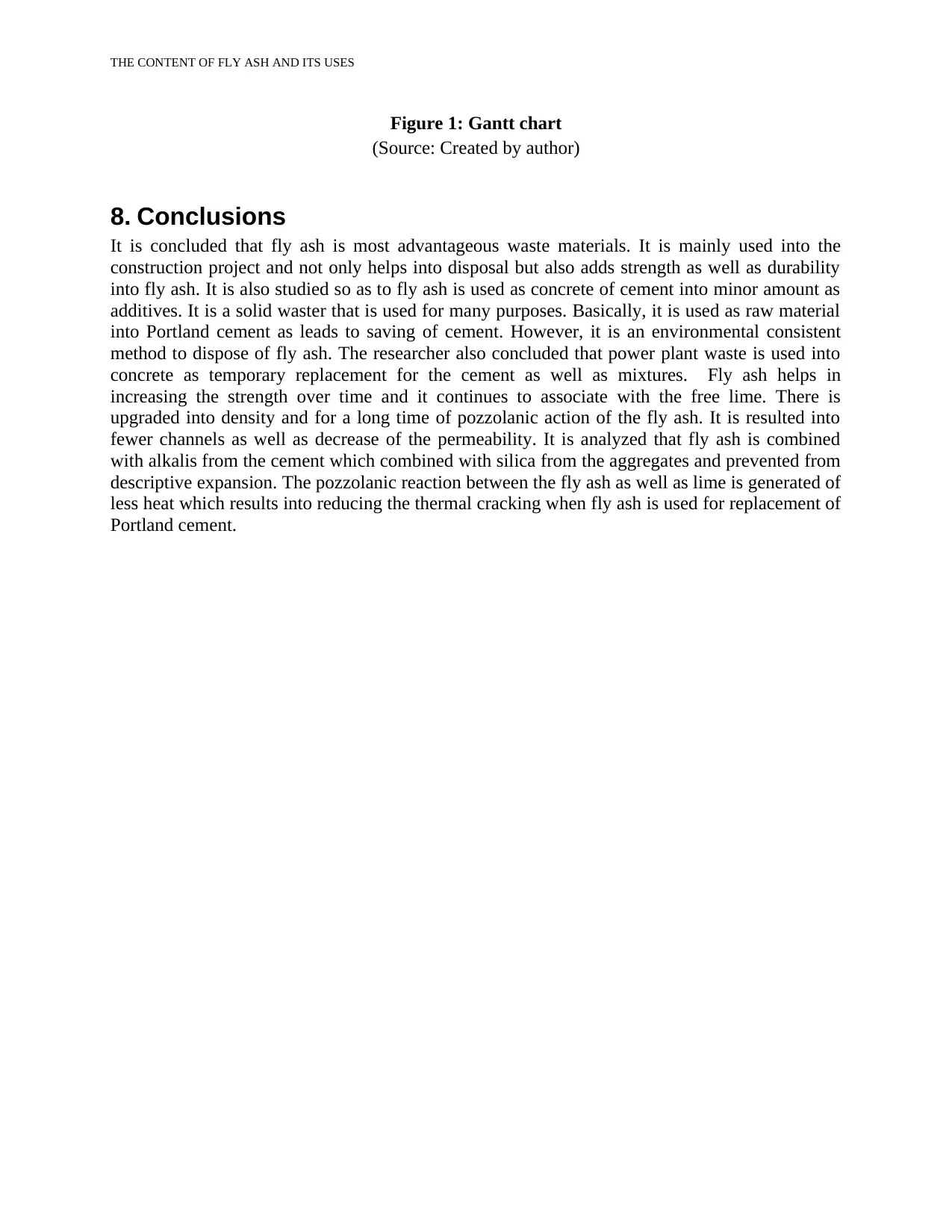
THE CONTENT OF FLY ASH AND ITS USES
Figure 1: Gantt chart
(Source: Created by author)
8. Conclusions
It is concluded that fly ash is most advantageous waste materials. It is mainly used into the
construction project and not only helps into disposal but also adds strength as well as durability
into fly ash. It is also studied so as to fly ash is used as concrete of cement into minor amount as
additives. It is a solid waster that is used for many purposes. Basically, it is used as raw material
into Portland cement as leads to saving of cement. However, it is an environmental consistent
method to dispose of fly ash. The researcher also concluded that power plant waste is used into
concrete as temporary replacement for the cement as well as mixtures. Fly ash helps in
increasing the strength over time and it continues to associate with the free lime. There is
upgraded into density and for a long time of pozzolanic action of the fly ash. It is resulted into
fewer channels as well as decrease of the permeability. It is analyzed that fly ash is combined
with alkalis from the cement which combined with silica from the aggregates and prevented from
descriptive expansion. The pozzolanic reaction between the fly ash as well as lime is generated of
less heat which results into reducing the thermal cracking when fly ash is used for replacement of
Portland cement.
Figure 1: Gantt chart
(Source: Created by author)
8. Conclusions
It is concluded that fly ash is most advantageous waste materials. It is mainly used into the
construction project and not only helps into disposal but also adds strength as well as durability
into fly ash. It is also studied so as to fly ash is used as concrete of cement into minor amount as
additives. It is a solid waster that is used for many purposes. Basically, it is used as raw material
into Portland cement as leads to saving of cement. However, it is an environmental consistent
method to dispose of fly ash. The researcher also concluded that power plant waste is used into
concrete as temporary replacement for the cement as well as mixtures. Fly ash helps in
increasing the strength over time and it continues to associate with the free lime. There is
upgraded into density and for a long time of pozzolanic action of the fly ash. It is resulted into
fewer channels as well as decrease of the permeability. It is analyzed that fly ash is combined
with alkalis from the cement which combined with silica from the aggregates and prevented from
descriptive expansion. The pozzolanic reaction between the fly ash as well as lime is generated of
less heat which results into reducing the thermal cracking when fly ash is used for replacement of
Portland cement.
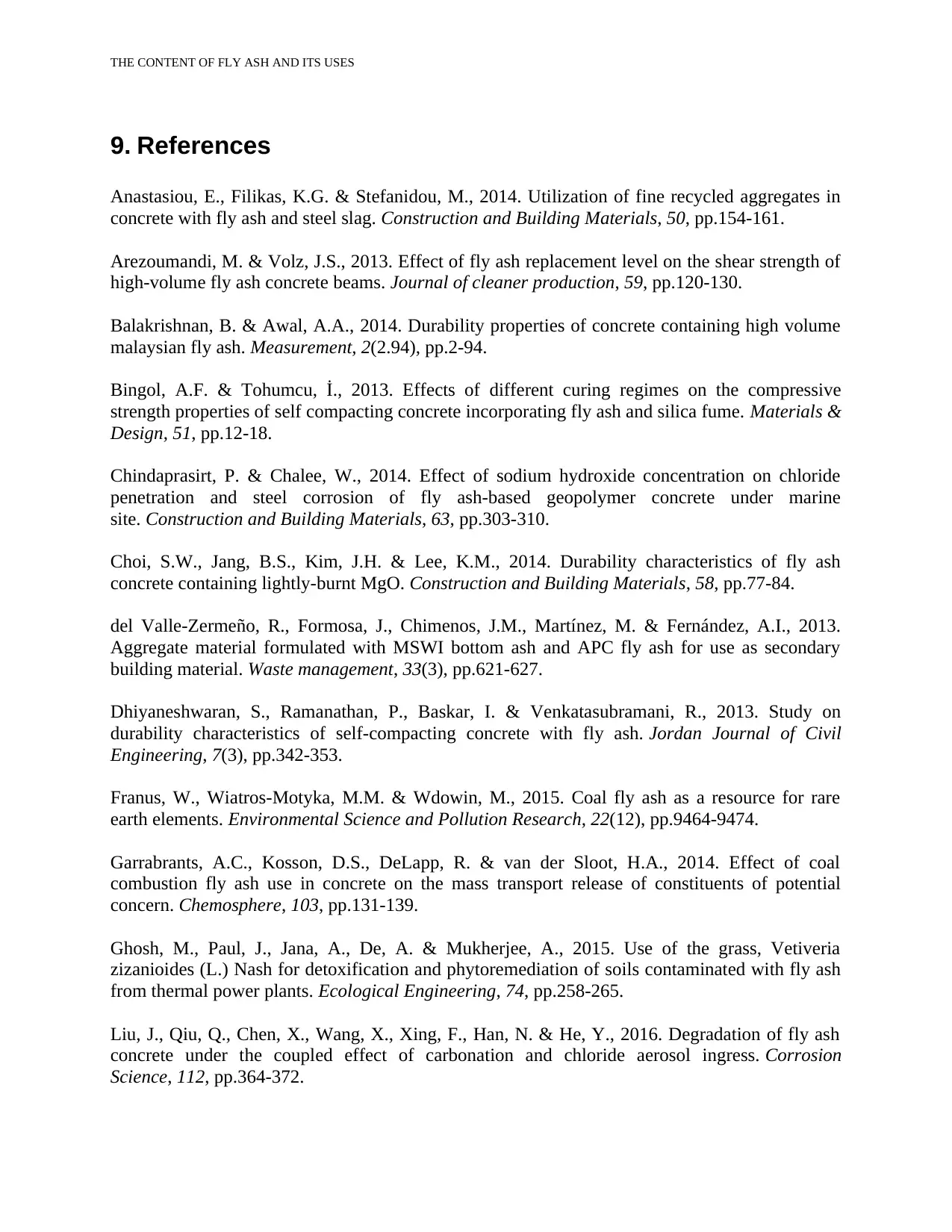
THE CONTENT OF FLY ASH AND ITS USES
9. References
Anastasiou, E., Filikas, K.G. & Stefanidou, M., 2014. Utilization of fine recycled aggregates in
concrete with fly ash and steel slag. Construction and Building Materials, 50, pp.154-161.
Arezoumandi, M. & Volz, J.S., 2013. Effect of fly ash replacement level on the shear strength of
high-volume fly ash concrete beams. Journal of cleaner production, 59, pp.120-130.
Balakrishnan, B. & Awal, A.A., 2014. Durability properties of concrete containing high volume
malaysian fly ash. Measurement, 2(2.94), pp.2-94.
Bingol, A.F. & Tohumcu, İ., 2013. Effects of different curing regimes on the compressive
strength properties of self compacting concrete incorporating fly ash and silica fume. Materials &
Design, 51, pp.12-18.
Chindaprasirt, P. & Chalee, W., 2014. Effect of sodium hydroxide concentration on chloride
penetration and steel corrosion of fly ash-based geopolymer concrete under marine
site. Construction and Building Materials, 63, pp.303-310.
Choi, S.W., Jang, B.S., Kim, J.H. & Lee, K.M., 2014. Durability characteristics of fly ash
concrete containing lightly-burnt MgO. Construction and Building Materials, 58, pp.77-84.
del Valle-Zermeño, R., Formosa, J., Chimenos, J.M., Martínez, M. & Fernández, A.I., 2013.
Aggregate material formulated with MSWI bottom ash and APC fly ash for use as secondary
building material. Waste management, 33(3), pp.621-627.
Dhiyaneshwaran, S., Ramanathan, P., Baskar, I. & Venkatasubramani, R., 2013. Study on
durability characteristics of self-compacting concrete with fly ash. Jordan Journal of Civil
Engineering, 7(3), pp.342-353.
Franus, W., Wiatros-Motyka, M.M. & Wdowin, M., 2015. Coal fly ash as a resource for rare
earth elements. Environmental Science and Pollution Research, 22(12), pp.9464-9474.
Garrabrants, A.C., Kosson, D.S., DeLapp, R. & van der Sloot, H.A., 2014. Effect of coal
combustion fly ash use in concrete on the mass transport release of constituents of potential
concern. Chemosphere, 103, pp.131-139.
Ghosh, M., Paul, J., Jana, A., De, A. & Mukherjee, A., 2015. Use of the grass, Vetiveria
zizanioides (L.) Nash for detoxification and phytoremediation of soils contaminated with fly ash
from thermal power plants. Ecological Engineering, 74, pp.258-265.
Liu, J., Qiu, Q., Chen, X., Wang, X., Xing, F., Han, N. & He, Y., 2016. Degradation of fly ash
concrete under the coupled effect of carbonation and chloride aerosol ingress. Corrosion
Science, 112, pp.364-372.
9. References
Anastasiou, E., Filikas, K.G. & Stefanidou, M., 2014. Utilization of fine recycled aggregates in
concrete with fly ash and steel slag. Construction and Building Materials, 50, pp.154-161.
Arezoumandi, M. & Volz, J.S., 2013. Effect of fly ash replacement level on the shear strength of
high-volume fly ash concrete beams. Journal of cleaner production, 59, pp.120-130.
Balakrishnan, B. & Awal, A.A., 2014. Durability properties of concrete containing high volume
malaysian fly ash. Measurement, 2(2.94), pp.2-94.
Bingol, A.F. & Tohumcu, İ., 2013. Effects of different curing regimes on the compressive
strength properties of self compacting concrete incorporating fly ash and silica fume. Materials &
Design, 51, pp.12-18.
Chindaprasirt, P. & Chalee, W., 2014. Effect of sodium hydroxide concentration on chloride
penetration and steel corrosion of fly ash-based geopolymer concrete under marine
site. Construction and Building Materials, 63, pp.303-310.
Choi, S.W., Jang, B.S., Kim, J.H. & Lee, K.M., 2014. Durability characteristics of fly ash
concrete containing lightly-burnt MgO. Construction and Building Materials, 58, pp.77-84.
del Valle-Zermeño, R., Formosa, J., Chimenos, J.M., Martínez, M. & Fernández, A.I., 2013.
Aggregate material formulated with MSWI bottom ash and APC fly ash for use as secondary
building material. Waste management, 33(3), pp.621-627.
Dhiyaneshwaran, S., Ramanathan, P., Baskar, I. & Venkatasubramani, R., 2013. Study on
durability characteristics of self-compacting concrete with fly ash. Jordan Journal of Civil
Engineering, 7(3), pp.342-353.
Franus, W., Wiatros-Motyka, M.M. & Wdowin, M., 2015. Coal fly ash as a resource for rare
earth elements. Environmental Science and Pollution Research, 22(12), pp.9464-9474.
Garrabrants, A.C., Kosson, D.S., DeLapp, R. & van der Sloot, H.A., 2014. Effect of coal
combustion fly ash use in concrete on the mass transport release of constituents of potential
concern. Chemosphere, 103, pp.131-139.
Ghosh, M., Paul, J., Jana, A., De, A. & Mukherjee, A., 2015. Use of the grass, Vetiveria
zizanioides (L.) Nash for detoxification and phytoremediation of soils contaminated with fly ash
from thermal power plants. Ecological Engineering, 74, pp.258-265.
Liu, J., Qiu, Q., Chen, X., Wang, X., Xing, F., Han, N. & He, Y., 2016. Degradation of fly ash
concrete under the coupled effect of carbonation and chloride aerosol ingress. Corrosion
Science, 112, pp.364-372.
⊘ This is a preview!⊘
Do you want full access?
Subscribe today to unlock all pages.

Trusted by 1+ million students worldwide
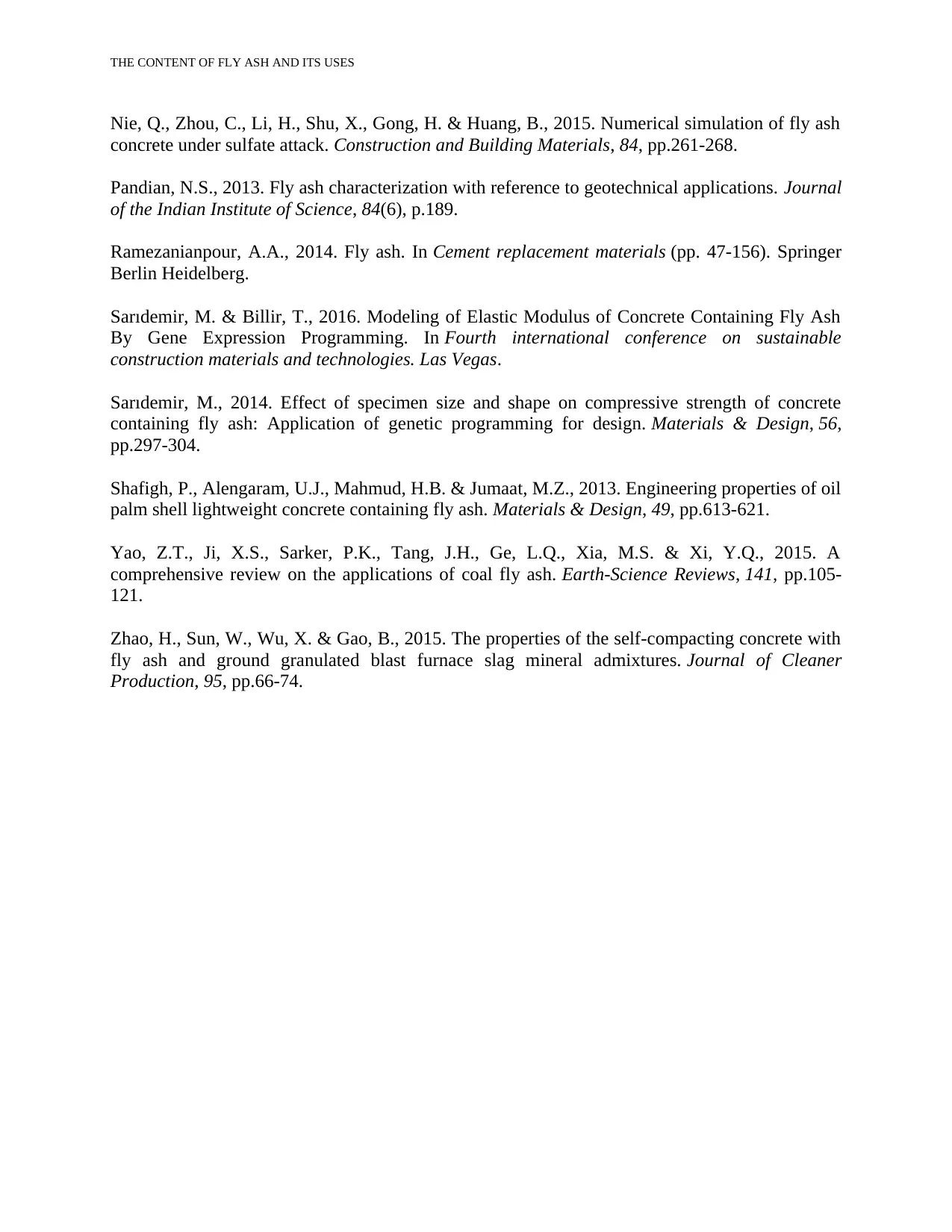
THE CONTENT OF FLY ASH AND ITS USES
Nie, Q., Zhou, C., Li, H., Shu, X., Gong, H. & Huang, B., 2015. Numerical simulation of fly ash
concrete under sulfate attack. Construction and Building Materials, 84, pp.261-268.
Pandian, N.S., 2013. Fly ash characterization with reference to geotechnical applications. Journal
of the Indian Institute of Science, 84(6), p.189.
Ramezanianpour, A.A., 2014. Fly ash. In Cement replacement materials (pp. 47-156). Springer
Berlin Heidelberg.
Sarıdemir, M. & Billir, T., 2016. Modeling of Elastic Modulus of Concrete Containing Fly Ash
By Gene Expression Programming. In Fourth international conference on sustainable
construction materials and technologies. Las Vegas.
Sarıdemir, M., 2014. Effect of specimen size and shape on compressive strength of concrete
containing fly ash: Application of genetic programming for design. Materials & Design, 56,
pp.297-304.
Shafigh, P., Alengaram, U.J., Mahmud, H.B. & Jumaat, M.Z., 2013. Engineering properties of oil
palm shell lightweight concrete containing fly ash. Materials & Design, 49, pp.613-621.
Yao, Z.T., Ji, X.S., Sarker, P.K., Tang, J.H., Ge, L.Q., Xia, M.S. & Xi, Y.Q., 2015. A
comprehensive review on the applications of coal fly ash. Earth-Science Reviews, 141, pp.105-
121.
Zhao, H., Sun, W., Wu, X. & Gao, B., 2015. The properties of the self-compacting concrete with
fly ash and ground granulated blast furnace slag mineral admixtures. Journal of Cleaner
Production, 95, pp.66-74.
Nie, Q., Zhou, C., Li, H., Shu, X., Gong, H. & Huang, B., 2015. Numerical simulation of fly ash
concrete under sulfate attack. Construction and Building Materials, 84, pp.261-268.
Pandian, N.S., 2013. Fly ash characterization with reference to geotechnical applications. Journal
of the Indian Institute of Science, 84(6), p.189.
Ramezanianpour, A.A., 2014. Fly ash. In Cement replacement materials (pp. 47-156). Springer
Berlin Heidelberg.
Sarıdemir, M. & Billir, T., 2016. Modeling of Elastic Modulus of Concrete Containing Fly Ash
By Gene Expression Programming. In Fourth international conference on sustainable
construction materials and technologies. Las Vegas.
Sarıdemir, M., 2014. Effect of specimen size and shape on compressive strength of concrete
containing fly ash: Application of genetic programming for design. Materials & Design, 56,
pp.297-304.
Shafigh, P., Alengaram, U.J., Mahmud, H.B. & Jumaat, M.Z., 2013. Engineering properties of oil
palm shell lightweight concrete containing fly ash. Materials & Design, 49, pp.613-621.
Yao, Z.T., Ji, X.S., Sarker, P.K., Tang, J.H., Ge, L.Q., Xia, M.S. & Xi, Y.Q., 2015. A
comprehensive review on the applications of coal fly ash. Earth-Science Reviews, 141, pp.105-
121.
Zhao, H., Sun, W., Wu, X. & Gao, B., 2015. The properties of the self-compacting concrete with
fly ash and ground granulated blast furnace slag mineral admixtures. Journal of Cleaner
Production, 95, pp.66-74.
1 out of 10
Related Documents
Your All-in-One AI-Powered Toolkit for Academic Success.
+13062052269
info@desklib.com
Available 24*7 on WhatsApp / Email
![[object Object]](/_next/static/media/star-bottom.7253800d.svg)
Unlock your academic potential
Copyright © 2020–2025 A2Z Services. All Rights Reserved. Developed and managed by ZUCOL.





